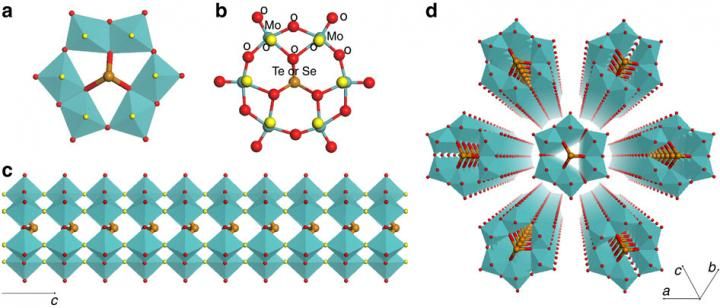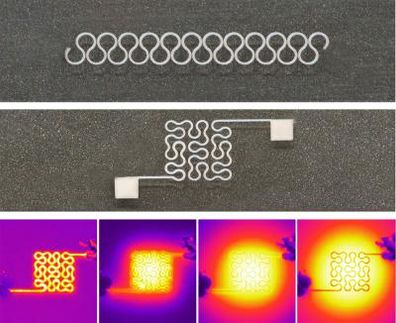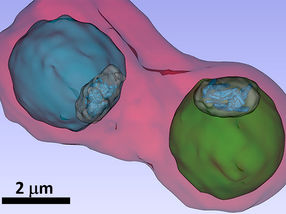Ultra-thin, all-inorganic molecular nanowires successfully compounded
nanowires are wired-shaped materials with diameters that are tens of nanometers or less. There are many types of nanowires, including semiconducting composite nanowires, metal oxide composite nanowires, and organic polymer nanowires, and they are typically used in functional materials and devices used as sensors, transistors, semiconductors, photonics devices, and solar cells.

This diagram shows structure of Mo-Te oxide nanowire. (a) Polyhedral representation and (b) ball-and stick representation of a hexagonal unit of [TeIVMoVI6O21]2-, (c) a single molecular wire of Mo-Te oxide. The bridge oxygen atoms that connect the hexagonal units are highlighted in yellow. (d) Assembly of single molecular wires into crystalline Mo-Te oxide. Mo: blue, Te (Se): brown, O: red.
Zhang, et al., Nature Communications 6, 7731, Fig. 3.
Molecular wires composed of only inorganic materials have attracted significant attention due to their stable structures, tunable chemical compositions, and tunable properties. However, there have only been a few reports regarding the development of all-inorganic molecular nanowires.
Dr. Zhenxin Zhang and Prof. Wataru Ueda at the Catalysis Research Center at Hokkaido University (Prof. Ueda is currently working for Kanagawa University) and their collaborators at Hokkaido University, Hiroshima University, and Japan Synchrotron Radiation Research Institute/SPring-8 successfully created ultrathin all-inorganic molecular nanowires, composed of a repeating hexagonal molecular unit made of Mo and Te; the diameters of these wires were only 1.2 nm. These nanowires were obtained by the disassembly of the corresponding crystals through cation exchange and subsequent ultrasound treatment.
Furthermore, the researchers have shown that the ultrathin molecular wire-based material exhibits high activity as an acid catalyst, and the band gap of the molecular wire-based crystal is easily tuned via heat treatment. It is expected that the metal oxide molecular wire-based materials will open up new fields of research in heterogeneous catalysts, thermochromic materials, and semiconductors, as well as other related fields.
"This is a very rare isolated molecular nanowire based on transition metal-oxygen octahedra, and is an attractive catalyst due to the large surface area," said Professor Masahiro Sadakane, a coauthor of this study, from Hiroshima University.
Original publication
Zhenxin Zhang, Toru Murayama, Masahiro Sadakane, Hiroko Ariga, Nobuhiro Yasuda, Norihito Sakaguchi, Kiyotaka Asakura, Wataru Ueda, "Ultrathin Inorganic Molecular Nanowires based on Polyoxometalates," Nature Communications (2015) 6, 7731.
Most read news
Original publication
Zhenxin Zhang, Toru Murayama, Masahiro Sadakane, Hiroko Ariga, Nobuhiro Yasuda, Norihito Sakaguchi, Kiyotaka Asakura, Wataru Ueda, "Ultrathin Inorganic Molecular Nanowires based on Polyoxometalates," Nature Communications (2015) 6, 7731.
Organizations
Other news from the department science

Get the chemical industry in your inbox
By submitting this form you agree that LUMITOS AG will send you the newsletter(s) selected above by email. Your data will not be passed on to third parties. Your data will be stored and processed in accordance with our data protection regulations. LUMITOS may contact you by email for the purpose of advertising or market and opinion surveys. You can revoke your consent at any time without giving reasons to LUMITOS AG, Ernst-Augustin-Str. 2, 12489 Berlin, Germany or by e-mail at revoke@lumitos.com with effect for the future. In addition, each email contains a link to unsubscribe from the corresponding newsletter.













![[Fe]-hydrogenase catalysis visualized using para-hydrogen-enhanced nuclear magnetic resonance spectroscopy](https://img.chemie.de/Portal/News/675fd46b9b54f_sBuG8s4sS.png?tr=w-712,h-534,cm-extract,x-0,y-16:n-xl)









































